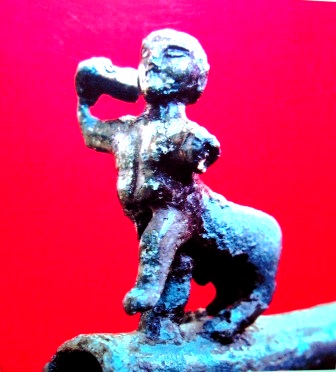Centauro Romano de Canas de Senhorim
Horácio Manuel Silva Peixoto recolheu em prospecção, um bronze romano proveniente da Quinta do Fojo em Canas de Senhorim que entregou à Sala Museu de Arqueologia dos BVCdS em 2000.
Objecto que constitui até à presente data, a primeira referência a uma possível ocupação romana daquele local. Trata-se de um elemento terminal de um objecto de culto, uma pátera em bronze um dos poucos exemplares encontrados em território português.
Pátera_Taça usada nos sacrifícios, nos tempos antigos.(Porto Editora)
Trabalhos de arqueologia da EAM ,6 , Lisboa , Colibri, 2000
Analysis of a Roman Centaurus from Canas de Senhorim (Portugal)
-Comparative study using EDXRF and SXRFM.F. Araujo1, T. Pinheiro1, P. Valério1, A. Barreiros2, A. Simionovici3, S. Bohic3 and A. Melo41 Instituto Tecnologico e Nuclear, Estrada Nacional 10, 2686-953 Sacavém, Portugal2 Instituto Nacional de Engenharia e Tecnologia Industrial, Azinhaga dos Lameiros, 1649-038 Lisboa, Portugal3 European Synchrotron Radiation Facility, BP. 220, 38043 Grenoble cedex, France4 Museum Nacional de Arqueologia, Mosteiro dos Jeronimos, Praça do Império, 1400-206 Lisboa, PortugalAbstractA decoration figure of a ritual bronze vase from Canas de Senhorim (Portugal) was analysed by Energy Dispersive X-Ray Fluorescence (EDXRF) spectrometry and Synchrotron Induced X-Ray Fluorescence (SXRF) microprobe spectrometry.
This artefact, a Centaurus constitutes the first evidence for a possible Roman occupation of this region of Central Portugal and it is also one of the very few artefacts of this type ever found. The determination of the Centaurus alloy composition will be important in me further comprehension of the metallurgical technologies used by the Romans in this region. EDXRF analysis of the corroded surface were made using the monochromatic radiation emitted by Ag and Gd secondary targets excited by a Rh X-ray tube at 35kV and 57 kV, respectively. SXRF experiments were carried out both on the corroded surface and on a small clean area of the artefact, using both monochromatic and polychromatic excitations with 32 keV and 12 keV radiations. EDXRF results allowed the determination of the alloy bulk composition. The SXRF comparative analysis between the clean and corroded areas evidences the surface enrichment in Sn and establishes the composition of the original alloy. The Centaurus alloy is a bronze with rather high Pb content, which is characteristic of the Roman decorative artefacts.
articles/jp4/abs/2003/02/jp4pr2p523/jp4pr2p523.html














5 comentários:
Se calhar foi em minha casa!... ;D
quem sabe?
estará a sua casa edificada na área de uma antiga "civitas" romana?
Até moedas romanas lá eu encontrei... Bem, mas a casa não se pode dizer que é minha!
Sabe qual é o exacto local dos achados?
Se puder envie fotos dessas moedas.
O Peixoto é um Sr.
Cumprimentos
Enviar um comentário